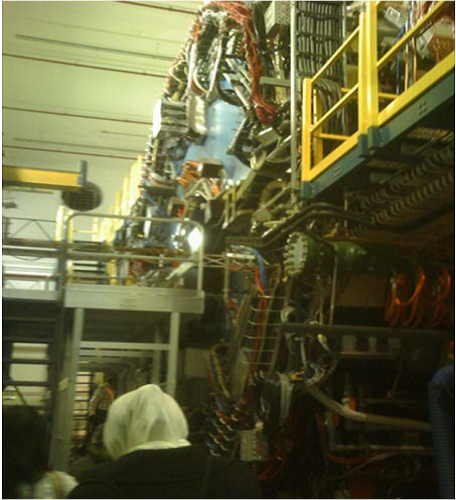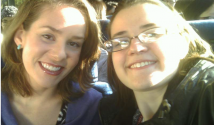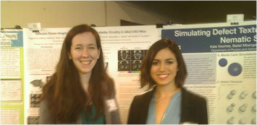Conferences for Undergraduate Women in Physics
January 17, 2014 to January 19, 2014
Stony Brook University and Brookhaven National Laboratory
Meeting host: By:Marie Blatnik
SPS Chapter:

In January, undergraduate women from all over the country gathered simultaneously in eight geographic regions to celebrate physics, learn from female role models, and inspire and network with each other. The SPS chapter at my home school of Cleveland State University has an above average number of female physics undergraduates. We are active with grade school outreach activities, seminars, and a physics Olympics. The chapter strongly encouraged all of the female physicists to attend this conference.
My motivation for attending the conference was rather personal. I had recently ended a relationship with a male physicist that I considered my best-case scenario for building a family. As a result, I had serious doubts about my ability to have a family while pursuing my research passions. Furthermore, the East Coast conference was held at Stony Brook University, where I had previously done research on the sPHENIX upgrades and Cherenkov detector development for the PHENIX collaboration. I looked forward to seeing my Stony Brook and Brookhaven community again, and the chance to seek affirmation and advice on my ability to pursue research and create a family. At the meeting, however, I took away many inspirations that I could not have imagined.
Dr. Doon Gibbs welcomed the female physicists to Brookhaven National Lab (BNL) on the opening day, expressing welcome and inviting us to write to him directly if we wanted to work at the lab. “We absolutely need you,” he affirmed, “from all walks of life, from all genders, from all races.” He had chosen to be late to a meeting in New York City in order to inspire us and recruit us for the work at BNL. “Really great ideas come from the people we bring in,” he said, stressing that we are a valuable asset to the physics effort.
Dr. Jehanne Gillo then introduced us to the money behind the muscle, how physics is funded by the Department of Energy, before we split into tour groups to see the BNL facilities. We learned how the collider-accelerator department bent and tracked the ion beam as it made its way from the tandem accelerators to the Alternating Gradient Synchrotron and the Relativistic Heavy Ion Collider (RHIC). The main control room displayed screens of magnet currents and intensity waveforms, prompting many questions about the detectors and large spectrometers to be seen later that day.
The tour group then headed to the National Synchrotron Light Source (NSLS), a mess of foil-covered beam pipe, vacuum windows, and experiment hutches. The accelerator products here were not the focus of the science, but used to “illuminate” the structure of the subject, whether a materials science compound or an inorganic macromolecule of interest to biology. Synchrotrons were originally developed for particle science, but now they apply to any experiment needing a high-luminosity source of x-rays to image their target of interest. Scientists from all over, especially in the northeastern United States, come to Brookhaven to use the huge, intricate, and expensive machine. We also toured the brand new NSLS II, which will serve many more experiments with greater organization and space when it is completed and comes online.
My favorite part of the tour was the experiment at one of the RHIC interaction regions. My group entered the bay where STAR, an energy-mass spectrometer, tracks and measures the particles produced by RHIC collisions. The big, colorful spectrometer dwarfed us as we asked questions about the different detectors and various hoses and wires leading in and out of the giant conglomeration of devices.
Something about the detector evokes tears in me. It may be awe for the largest of machines probing the smallest parts of the universe. It may be that the detector represents a unity of scientists collaborating together precisely and perfectly from hundreds of institutions, all in the interest of probing the questions of the nature of the universe. Or, perhaps it is because the detector is something huge and beautiful and I want to be a part of its team. At that moment, staring at the STAR detector, I resolved to ask my contact at a rival experiment on the beam line, PHENIX, if I could take some beam shifts for the next data run. That contact was luckily running the conference, Dr. Deshpande, who encouraged me to do so. I was ecstatic.
The afternoon consisted of a poster session where 33 posters featuring undergraduate physics research were presented by women to women. Jasmine Abdollahi, one of the presenters, taught me about using photodiodes to look for neutrino-less double-beta decay of radioactive Xenon. Kelsie Krafton explained to me the different types of supernovae, presenting a poster on one supernova’s relevance to early dust evidence. Kelly Blumenthal showed me color printouts of a sky with stars repeating in different places, distortions as a result of galaxy lensing. I presented a poster on the Hadron-Blind Ring Imaging Cherenkov Detector from my past year’s Stony Brook research. The presentations were lively and filled with information exchange and explanations about physics that I was aware of, and more physics that I did not know existed—from superlattices to tadpoles, from galaxies to nanorings. Presenters ranged from shy to confident, gaining experience and affirmation from sharing our wide variety of research experiences. The feeling that “we are physicists” seemed to permeate the poster session among the presenters.
The conference continued with presentations and advice from women physicists. Each one inspired us with their research and life stories.
Dr. Sally Dawson, an expert in the search for the Higgs Boson, explained the particle and its importance over dinner. She delved into the characteristics required by the Higgs Boson, and expressed why the search and the science was not over and wrapped in a nice tidy bow.
Dr. Meigan Aronson shared her research on the question of mutual exclusivity between superconductive and magnetic materials, explaining the phase diagrams of superconductive materials. Magnetic fields running through a superconductor will quench it, bringing it out of the region of superconductivity, thus calling into question the exclusivity of the two. Dr. Aronson also explained how she came to be a condensed matter physicist, admitting distaste for quantum mechanics. “In your life,” she explained, “many things – especially the biggest heartbreaks – will only make sense as you look back.” She shared that “after physics, nothing can scare you!”
Dr. Fulvia Pilat from Jefferson Lab explained accelerator science, from the basic concepts of strong focusing doublets to resonant radiofrequency acceleration. Her job coordinating accelerator science includes the “coexistence of academic and operations culture.” She told us the heartbreaking story of the Superconducting Super Collider in Dallas that was cancelled and the uplifting excitement of RHIC on Long Island that we had visited the previous day. She was an inspiration for me, as she had given birth every time she changed jobs. I asked her, “How do you personally have a kid and run an accelerator at the same time?” She admitted its difficulties, and advised us to manage time well and to accept help from spouses and family.
Dr. Crystal Bailey from the American Physical Society attended the conference to befriend and encourage us. She gave a talk about being open to jobs in industry. Being a physicist in industry is not “turning to the dark side” or “being evil,” but is a popular and opportunity-filled career option. Furthermore, she asserted that a “physicist is defined as anyone with a physics degree… [this] defines a common set of experiences…consistent with other disciplines.”
A roundtable, Life as an Academic, helped me greatly with the questions of family and physics that I was struggling with. Dr. Martin Rocek, a professor at Stony Brook, was the only male on the panel. He admitted to giving lectures with a piece of chalk in one hand and a baby in the other. Hopefully there is a guy like him out there for me.
On the way back to the hotel, Dr. Deshpande told us stories about his kids attending his lectures. He found that his daughter behaved well for the lectures if he told her what he would be teaching in class that day. One particular day, he explained that he would be teaching about gravity. He told her that gravity was what made things fall down. Dr. Desphande’s lecture hall contained chalkboards that rolled up and down on rails. He pushed one board to the top of the rails, and turned around to continue lecturing as the board slowly descended from its position. His daughter pointed at the board, and shouted, “Look, daddy! Gravity!” The whole class erupted in laughter. The lecture instantly became one they would never forget.
The best part of the conference for me was not an individual talk, but the supportive network and new friendships that were established. My hotel roommate, Tiffany LaByer, was a physicist from Stony Brook University that came back to school to pursue her questions about the universe and its connectivity. Claire Weaver came back to school after traveling the globe as an acrobat. She married her boyfriend after several years of a long-distance relationship, giving me hope that I could make a relationship work with the right person. I have so many new stories, new inspirations, and new friends from this conference. I have met people who have balanced family and physics, who have married a person who enable them to do physics, people who have found love and lost it, some who have found love and kept it, and those who have found amazing physics breakthroughs while feeling empowered and not enslaved by science.
I was scared, after my last relationship did not work out, that I would have to abandon my family fantasy for my physics. I was scared that I would have to choose between them. At this conference I found out that there are choices, but they aren’t so binary as mother or cutting-edge research scientist. I am determined to be a flavor of both. The physicists that I met are striving for similar goals, and we have created a network and friendships that will bring us together personally and professionally.
Areas of Alignment: Career Resources: Scientific Categories:

